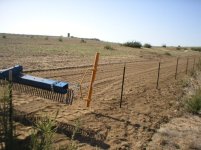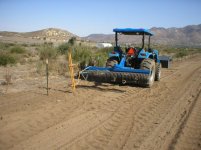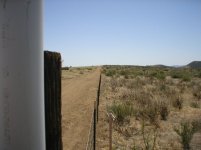Many times I've done fence lines 1/4 mile or more. We do it by eye. Afterall, don't you look down the line to verify after using a string or wire? Most west coast fence companys won't hire a foreman that uses string to set posts.
Basically I start off with a post at each end, normally here in Texas I set the post three to four inches inside the property line unless the neighbor is sharing the cost. Then I set it on the line. These posts are a just stabbed into the ground because they are temporary sight posts.
If I have a clear line of sight end to end then I won't use a middle post unless there is grade change. then I will place posts just off line at the height I want to use at the high and low points. I shoot height and line at the same time btw.
Let's say I'm setting posts on 8' centers, my most common situation. I will use either a claw hammer as a pick and scratch a line perpendicular to the line every eight feet across the line. Sometimes I use upside down paint. If you use upside down paint try to use white. Utility locators can then distinguish your post marks from other utility marks. The worst color to use is orange because it is telco and cable marking color. If you are along the road then chances are most likely you will have a lot of those.
Once the post marks are in I come back with a sight post midway for line. I then sight down the line starting at one end using the mid post and the other end post for line. When I hit the mid post I have to turn around and sight backwards towards the other end post. At each post I use either the scratch mark or upside down paint to mark the line. At every post I should have a plus sign.
Next I dig my holes. I will center the auger over a post width over every plus sign, same side, doesn't matter which side. This is to keep the posts in the middle of the holes.
When the holes are dug I will set the two end posts. I will then set the third post followed by the second post. I do what is called back sighting because I usually work alone. If I have help I can wear two men out keeping me in concrete. Like I said, I set the posts for height and line. Most of my big jobs are pipe fence so all the posts are notched, coped, fish mouthed, fitted up, prior to use. Ends and corners I turn the cope down instead of having it up.
When you are setting pipe fence with a top rail you need a height mark 1/2 inch below the top rail diameter at each end or corner. You shoot your height to that mark instead of the top of the posts. Gate posts are shot to the top of the posts.
When sighting in the posts you always shoot to the same side. Let's say I'm doing line posts. I grab the post and center it into the hole, especially in line. Using a plumb level I hold the post plumb and look back at the last post set. I move my post plumb to where the end post disappears behind the next post. I put in concrete. I like my concrete stiff, not dry, but not watery. This allows me to pull the post up for height using the same technique of watching the next post disappear behind the post I'm setting for height. Once the post is set for height and line I go back to the last post and look down towards the other end to verify I'm keeping everything straight.
This takes minutes. In fact when I'm in the zone doing this the post just seems to jump in line and at height. When that happens like I said I can kill two helpers keeping me in concrete with one of them feeding a nine cubic foot mixer and the other shuffling concrete with two wheel barrows.
A couple of tips, one you always start work at the post furtherest away from where your materials are. As you wear down the distance to haul material is shorter. Two, NEVER EVER kick in dirt to cheat on concrete or fail to clean your post holes with post hole diggers even if you are using an auger to dig your holes. If you use concrete the top ten inches of your hole you have now created a very bad thing for the future. First you have created a fulcrum that allows your post to lean easily. The second you have done is the soil in your hole is less dense than the surrounding soil. Water is eventually going to seep down in that cavity and your soil will now compact. When the ground is wet your post will sink.
There's a lot of discussion about whether to use concrete or not. I like concrete for livestock fence. Here's the logic. If pressure is applied against a post without concrete the only resistance is the width of the post. If you have a proper concrete set post you have the diameter of the footer. That can be huge.
If you are working in clay soils there are a couple of other things to consider. One is you have to watch your augers for wear. If your auger is worn you will be making a taper hole. When the clay gets wet and expands that provides a surface for pushing the post up. The same happens when you over fill you hole and leave a mound above the hole. This can be a serious issue over time because the crown or mound will be above the grade when the clay dries and shrinks away from the post. You now have a hazard if you have a horse. Btw, it never falls back down when it dries, it always continues to rise each wet/dry cycle.
I hope this helps. I've only been doing this professionally since the early seventies.


